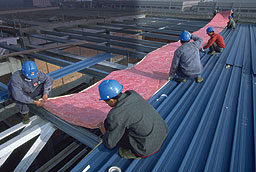 |
| (Photo courtesy of Parsons Brinckerhoff) |
Economists are getting a jump on the 2004 New Years celebration. Most industry forecasts call for total construction volume next year to remain near record levels with a slightly different mix as the depressed industrial, office and commercial building markets begin to rebound just as moderately higher interest rates slow housing.
Miraculously, these forecasts were followed by a long list of good statistics, not the least being announcements that the U.S. gross domestic product grew at an astounding annual rate of 7.2% in the third quarter. Manufacturing activity also hit a 20-year record and employment started rising.
However, contractors may want to keep the cork in the champagne at least until St. Patricks Day. ENRs cost report shows contractors still using recession pricing in their bids and there is a hint that inflation may be gaining strength.
But the biggest party pooper may be a chronic weak dollar, which will change some of the ground rules from the last economic expansion.
Cheap imports, energy and money fueled much of the economic growth of the 1990s. While a weak dollar will help steel fabricators and erectors compete with their Canadian counterparts, it also will make most imported construction materials more expensive and could indirectly threaten low interest rates in the not-too-distant future.
"So far, the dollar has come a long way down without major disruptions," says Nigel Gualt, U.S. economist with the forecasting firm Global Insights, Lexington, Mass. "But at some point the decline in the dollar will cause foreigners to flee from U.S. assets, resulting in a very sharp increase in interest rates."
|
|
| Forecast: Inflation will match this years gains |
| International: Asia breaks deflation cycle |
| Reconstruction: The cost of working under fire |
| Equipment: Chinas path toward productivity |
| Compensation: Lower salary expectations |
|
|
| Builders' Construction Cost Index |
| Construction Material Price Movement in 2003 |
The best scenario would be for the dollar to stabilize a little below its current level, which "would mean youve managed the adjustment," says Gualt. However, even then "you could still get into trouble [with interest rates] as the federal government competes for funds from a revived private sector," he adds.
The gap between a contractors input costs and selling price continues to widen. This quarter, eight general building cost indexes measuring labor and material costs posted an average annual increase of 3.3%. This is 2.8% higher than the 0.5% annual increase reported for three cost indexes that measure selling price (see table above).
A surge in lumber prices kicked ENRs cost indexes up a notch. The average annual escalation rate for both ENR cost indexes rose from 1.1% in July to 3.3% in December. In this issue, ENR forecasts the indexes to increase another 3.2% by the end of next year.
Worldwide, inflation is forecasted to average 3% in 2004, according to ENRs annual survey of international construction costs conducted by Gardiner & Theobald Inc., London.
In the U.S., building inflation in 2004 will get one of its biggest pushes from rising steel prices. During the fourth quarter, an acute shortage of scrapthe basic raw material for electric furnaces that produce most structural steel and rebarpushed mill prices for steel and rebar products through the roof.
"These are the largest and most rapid price increases we have seen from the mills in years," say Robert Abramson, CEO of Interstate Iron Works, Whitehouse, N.J. Bob Back, chairman of Barker Steel Co., a large Milford, Mass.-based rebar fabricator, says he has "never seen mill prices this high."
"Steel prices are near an all-time high and there is not the construction activity to justify it," says John Anton, steel analyst for Global Insights. The culprit is a huge demand for scrap in China that is drying up supplies, he says. This has been pushing up scrap prices since mid-2002. An 18% price hike in the fourth quarter pushed prices 40% above a year ago.
Prices for light structurals reacted with a 10.7% price increase during the fourth quarter, leaving prices 8.3% higher than a year ago. These prices are going to stick because if they fall, mills will be operating at a loss, says Anton. He predicts that prices for light structurals will increase 4.2% next year and another 2.3% in 2005.
Rebar prices will peak in the fourth quarter to 8.5% higher than a year ago and then begin to slide. Anton expects rebar prices to fall 2.7% in 2004, followed by another 2.1% decline in 2005.
This month, President Bush scrapped the U.S. tariffs on foreign steel, but Anton says the move will not attract imports into the U.S. and drive down prices because exchange rates are keeping imports at bay. Ending tariffs will merely keep prices from going even higher. Abramson believes that prices already are close to the point were they will start drawing imports back into the market.
Trade issues also will have an impact on lumber prices in 2004. It is widely believed that the U.S. and Canada are close to settling their dispute over Canadian imports, which could reduce stiff U.S. tariffs now placed on Canadian lumber. The tentative deal apparently would give Canada 31.5% of the U.S. lumber market and require it to pay a $200-per- thousand-bd-ft duty for imports beyond that point. Canada traditionally accounts for about 34% of U.S. lumber consumption.
"The deal will make the market more volatile and you will see higher highs and lower lows next year," says Paul Jannke, vice president of wood products for Resource Information Systems Inc., Bedford, Mass. RISI predicts prices for 2 x 4 western spruce lumber will peak next year at $360 per mbf, compared to this years peak of $355. Prices then will fall to $240 by year-end, compared to this Decembers price of $292, says Jannke.

Post a comment to this article
Report Abusive Comment